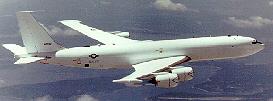E-6A/B MERCURY
The E-6A/B, derived from the Boeing 707, is a command, control, and
communications (C3) platform. The E-6A's Take Charge and Move Out (TACAMO)  mission
provides multiple C3 links for Emergency Action Message (EAM) relay from
the National Command Authority to strategic and non-strategic operating
forces. Designed to support a robust and flexible nuclear deterrence posture
into the 21st century, the E-6B is currently incorporating Airborne National
Command Post (ABNCP) equipment from retiring U.S. Air Force EC-135Cs. E-6As
became fully operational in 1992, and E-6B initial operational capability
will occur in 1998.
mission
provides multiple C3 links for Emergency Action Message (EAM) relay from
the National Command Authority to strategic and non-strategic operating
forces. Designed to support a robust and flexible nuclear deterrence posture
into the 21st century, the E-6B is currently incorporating Airborne National
Command Post (ABNCP) equipment from retiring U.S. Air Force EC-135Cs. E-6As
became fully operational in 1992, and E-6B initial operational capability
will occur in 1998.
E-6As transmit and receive secure and non-secure voice and data at very
low, low, and high frequencies, and also via UHF line-of-sight and satellite
communications systems. The E-6A can deploy a 28,000-foot trailing-wire
antenna and a 5,000-foot short trailing-wire antenna for Very Low Frequency
(VLF) communications with submerged ballistic missile submarines. With
in-flight refueling, the E-6B ABNCP is capable of providing up to 72 airborne
hours of decision-level conferencing, force management, situation monitoring,
and communications support.
The E-6B retains all E-6A capabilities and adds:
-
Battle staff compartment for C3 operations and an Airborne Launch Control
Center for ICBM programming and launch
-
Orbit Improvement System for increased VLF and low frequency (LF) transmit
antenna efficiency
-
GPS for improved navigation and timing signals
-
UHF frequency division multiplexing for air/air and air/ground links; six
STU-IIIR phones for secure voice and data transmissions; an LF transmit
capability for increased frequency spectrum; and a Milstar EHF/UHF command
post terminal for secure, survivable C3.
Follow-on improvement programs under consideration are a Multi-function
Display System (MDS) for meeting Federal Aviation Administration and ICAO
flight management and terminal requirements, and additional satellite C3
capabilities for improved Global Command and Control System interoperability
supporting theater CINC missions.
 System
Overview
System
Overview  Safety
Safety  Affordable
Avionics
Affordable
Avionics  C4/ISR
C4/ISR  Aircraft
Carriers
Aircraft
Carriers  Carrier
Air Wings
Carrier
Air Wings
 F-14
Tomcat
F-14
Tomcat  F/A-18
Hornet
F/A-18
Hornet  Joint
Strike Fighter
Joint
Strike Fighter  Airborne
Reconnaissance Vision
Airborne
Reconnaissance Vision  E-2C
Hawkeye
E-2C
Hawkeye  S-3B
Viking
S-3B
Viking
 ES-3A
Shadow
ES-3A
Shadow  Common
Support Aircraft
Common
Support Aircraft  EA-6B
Prowler
EA-6B
Prowler  Helicopter
Master Plan
Helicopter
Master Plan
 Marine
Corps Fixed-Wing Aircraft
Marine
Corps Fixed-Wing Aircraft  Marine
Corps Rotary-Wing Aircraft
Marine
Corps Rotary-Wing Aircraft  P-3C
Orion
P-3C
Orion  EP-3E
Aries II
EP-3E
Aries II  E-6A/B
Mercury
E-6A/B
Mercury
 Air-to-Air
Missiles
Air-to-Air
Missiles  Air-to-Ground
Weapons
Air-to-Ground
Weapons  Air-to-Subsurface
Weapons
Air-to-Subsurface
Weapons  Naval
Reserve Aviation
Naval
Reserve Aviation  Logistics
Airlift
Logistics
Airlift
 Training
Aircraft
Training
Aircraft  Aircrew
Training
Aircrew
Training  Aviation
Specialized Skills Training
Aviation
Specialized Skills Training  Logistics
Logistics  Expeditionary
Airfields
Expeditionary
Airfields
 Air
Traffic Control
Air
Traffic Control  Ranges
and Airfields
Ranges
and Airfields


 mission
provides multiple C3 links for Emergency Action Message (EAM) relay from
the National Command Authority to strategic and non-strategic operating
forces. Designed to support a robust and flexible nuclear deterrence posture
into the 21st century, the E-6B is currently incorporating Airborne National
Command Post (ABNCP) equipment from retiring U.S. Air Force EC-135Cs. E-6As
became fully operational in 1992, and E-6B initial operational capability
will occur in 1998.
mission
provides multiple C3 links for Emergency Action Message (EAM) relay from
the National Command Authority to strategic and non-strategic operating
forces. Designed to support a robust and flexible nuclear deterrence posture
into the 21st century, the E-6B is currently incorporating Airborne National
Command Post (ABNCP) equipment from retiring U.S. Air Force EC-135Cs. E-6As
became fully operational in 1992, and E-6B initial operational capability
will occur in 1998.